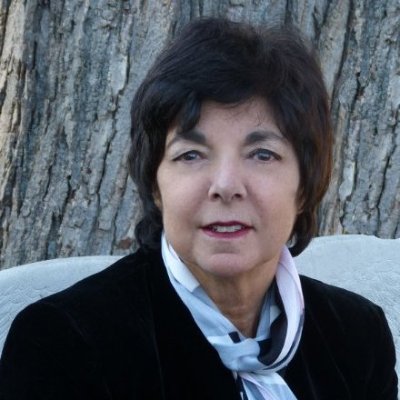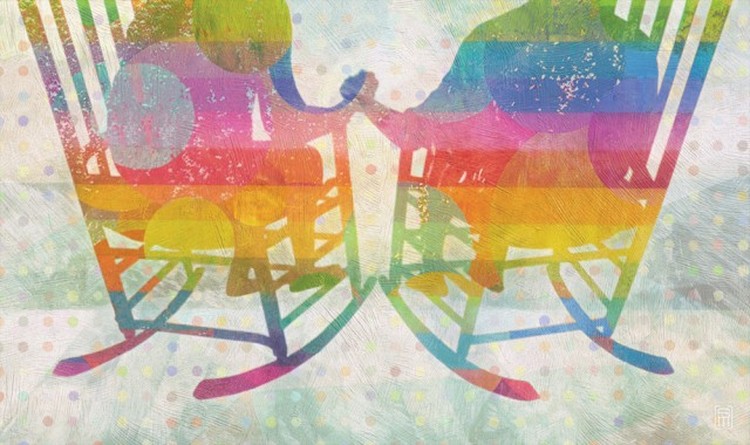What happens to LGBT couples when one of them must move into a nursing home? In this article, Ellen Rand answers that and other questions, including some that have heartbreaking answers. Rand is a journalist, hospice volunteer and author of Last Comforts: Notes from the Forefront of Late Life Care. Her article was posted on the New America Media website on April 29, 2016, and it’s reprinted here with permission.
Lawrence Johnson and Alexandre Rheume were an interracial couple who had been together 38 years until Rheume—22 years older than Johnson—needed professional care as his health declined.
At first Rheume moved to an assisted living development, but they both felt unwanted, uncomfortable and judged, as Johnson would do such simple things as holding his partner’s hand or feeding him. Rheume moved to a nursing home that felt more welcoming.
“It’s bad enough that you have to put someone in a nursing home,” Johnson explained to filmmaker Stu Maddux, whose documentary, Gen Silent, shares the experience of six LGBT elders in the Boston area. “Then to compound the fact, there may be prejudices, and the person going into the nursing home might not be treated as well—not in overt ways but all these subtle things that let you know you’re not wanted.”
For elders who are lesbian, gay, bisexual or transgender (LGBT) and contending with advanced illness, returning to the closet, fearing deliberate neglect, disapproval or abuse, is not uncommon.
Discrimination in Long Term Care
Their fears are not unfounded. In spring 2011, six organizations that advocate for elders and for the LGBT population published the study, LGBT Older Adults in Long-Term Care Facilities: Stories from the Field.
Among the highlights: only 22 percent said they could feel open about their sexual orientation with staff at a nursing home, assisted living or other long term care facility. Of those who lived in long term facilities or cared for those who did, the most frequently reported problem was negative treatment from other residents, followed by verbal or physical harassment by staff.
Moreover, half reported staff refusing to provide basic care (such as toileting, bathing or feeding).
Some respondents shared their sorrows and stories of lives derailed: couples separated by family members holding legal authority over the facility resident; feelings of loneliness and isolation because of disapproval by other residents or staff; aides attempting to get [them] to “repent” for their sins; choosing to go back into the closet for fear of neglect or harm.
A 2011 study by the Center for American Progress and [SAGE], Services and Advocacy for Gay, Lesbian, Bisexual and Transgender Elders, found LGBT seniors to be significantly more vulnerable to isolation. Very few have children, they are twice as likely to live alone, twice as apt to be single [as] heterosexual elders and often in poorer financial straits than their heterosexual peers.
According to the National Resource Center on LGBT Aging, the population of LGBT older adults in the United States will have more than tripled from about 2 million in 2010 to 7 million by 2030.
HIV and Discrimination
In addition, more than one-third of the 1.25 million people in the United States living with HIV in 2011 were aged 50 or older, according to the Centers for Disease Control and Prevention.
Speaking in April 2016 at the Association of Health Care Journalists’ annual conference, James Hekman, MD, a clinical assistant professor at the Lerner College of Medicine at Case Western University in Cleveland, listed a spectrum of HIV-associated illnesses, such as cardiovascular disease, non-AIDS cancers, liver, kidney and neurological diseases. Up to 30 percent of people living with HIV have abnormal kidney function, which, untreated, can be fatal….
Research has exposed health professionals’ widespread [biases]… The 2010 report, When Health Care Isn’t Caring, surveyed nearly 5,000 people on discrimination against LGBT people and those living with AIDS. About half of study participants reported that health care providers had refused needed care, declined to touch them or took other excessive precautions, blamed them for their health status or were physically rough or abusive.
In addition, transgender individuals reported being subjected to substantially more of these kinds of events. Transgender individuals generally are at a higher risk for experiencing advanced stages of long-term diseases due to their mistrust [of] the health care system and experience of rejection, discrimination or [health care professionals’] simple lack of medical knowledge about trans people.
“Health care providers do not know anything about us,” said one of eight people interviewed for the 2014 paper Aging With Pride: End of Life Conversations in Tucson’s Elder LGBT Communities by Penelope Starr, She explained that this speaker was a 50-something, female-to-male, transgender individual, who added that some health professionals “are just now starting to get a little in medical school, but they do not know how to talk to us—what our issues are. [They] do not have the right questions on their forms, do not know what is the appropriate hormone dosage and what to look for in blood work.”
Starr was one of a number of “citizen folklorists” engaged by the Southwest Folklife Alliance’s Continuum project, which shares cultural knowledge about traditions, expressions and practices associated with experiencing the end of life, mourning and death in Southern Arizona’s folk, ethnic, occupational, faith-based and alternative communities.
Suicide: A Real Possibility
When fear, isolation or depression become unbearable, suicide is a very real possibility, noted Imani Woody, PhD, founding director and president of the LGBT-friendly Mary’s House for Older Adults, slated to open in the Washington, DC, area next winter (2017).
“Research is showing that a large majority of older gay folks are going back into the closet. Anecdotally, we are finding their numbers climbing in the suicide rates,” said Woody, who blogs for the Diverse Elders Coalition.
She continued, “We know that the realities of living alone—not having a partner or spouse, leaving one’s home and becoming dependent on systems and people—can bring about a sense of loss and grief so great that suicide seems the only answer.”
What’s needed, Woody said, echoing LGBT individuals and advocates, is to “change the environments that cause our elders to run back into the closet for safety or commit suicide.”
Caregiving and grief took [their tolls] on Lawrence Johnson, who admitted to becoming increasingly isolated, depressed and suicidal as Alexandre Rheume’s health declined. But Johnson’s story has a happier ending than most: he began to write poetry and, after Rheume’s death, gradually began a new chapter and a new relationship.

Ellen Rand has been a journalist for 40 years, including an early stint as housing columnist for the New York Times. Today, she’s also a hospice volunteer—an experience she drew on for her book, Last Comforts: Notes from the Forefront of Late Life Care (2016). The book was a 2017 International Book Awards finalist and won an Independent Publisher Book Award the same year. Rand blogs at lastcomforts.com.



